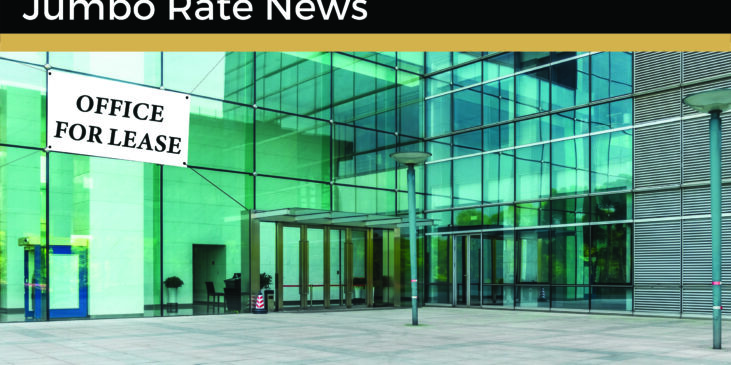Last week we reported on U.S. banks with robust Commercial & Industrial (C&I) loan growth during calendar 2021. In spite of the winding down of the Paycheck Protection Program (PPP), we found 51 established C&I lenders with at least 35% organic C&I growth last year. We also noted that some banks achieved that by moving away from highly volatile Commercial Real Estate (CRE) in favor of C&I loans.
Well before the pandemic, many parts of the country were dealing with so called “ghost malls” (JRN 36:30, 37:15). Now we can add ghost office buildings as well. While many workers are happy to return to the office setting, another group finds that working from home suits them just fine.
This week, we look at C&I & CRE lending together. On page 7 we have listed 56 community banks that each report that more than 50% of total loans is tied up in these business loans. They also reported more than 3% of these loans were delinquent 90 days or more at year-end 2021.
Nine of the community banks listed were not involved in PPP at all. The first bank, 4-Star Bank of Brewton, AL, is one such bank. But in spite of not having any PPP, and in spite of reducing its exposure to C&I loans by nearly 22% during 2021, it still reported that 33% of its entire loan portfolio is tied up in C&I. (It’s peer group reports an average of 12.3%.)
After cutting CRE by about 18% in 2021, Bank of Brewton’s CRE exposure is now much closer to that of its peers (18% vs. 16%). Combined, that’s 51% of total loans and a lot of exposure in local businesses. These commercial loans are running at about a 7% delinquency rate. Fortunately, the other 49% of its loan portfolio is in very good shape.
3-Star Neighborhood Nat’l Bank, San Diego, CA (JRN 37:42 Community Banks Going the Extra Mile) funded 750 PPP loans totaling $75 million. What remained on its books at the end of ’21 was just $3.188 million. Its entire C&I portfolio was cut by nearly 60% during the year. Its CRE exposure, on the other hand, was up substantially. Neighborhood now has over 55% of its loans in CRE with 3% of them reported as delinquent.
None of Neighborhood’s delinquent loans carry government guarantees, but over half of the delinquent loans at 5-Star FMS Bank, Fort Morgan, CO do carry such guarantees.
In spite of reducing its PPP, FMS Bank saw its C&I loans increase almost 18% during 2021. With CRE growth of 46.4%, nearly 57% of its loans are dedicated to community businesses. Compare that with 39% at its peer banks. We don’t anticipate any hiccups with these loans, but we have them on our radar.
Established in 1982 as Fort Morgan State Bank, FMS Bank witnessed slow and steady growth for many years. As the community’s growth has accelerated, so has the bank’s. FMS Bank now has two locations, its headquarter office in Fort Morgan (Morgan County) and a branch in Greeley (Weld County). And while it has been rated 5-Star for almost seven years, it has had some blips in the past, falling as far as to 3-Stars on more than one occasion, the last time being more than two decades ago (Q2 of 2000).
It is clearly an attractive market as 14 other banks have branches in at least one of the two towns. In fact, Fort Morgan reported job growth of 4.7% over last year and is projected to see another 53.4% growth over the next ten years (source: Sperling’s Best Places). And Greeley has reportedly been ranked as the fastest growing city in Colorado.
Five of the banks on page 7 are rated 2-Stars or lower and therefore can also be found on Bauer’s Troubled and Problematic Bank (T&P) Report. Naturally, we are more concerned about these, particularly Zero-Star Grand Rivers Community Bank, Grand Chain, IL.
Grand Rivers was relegated to Bauer’s T&P (for the second time) based on first quarter 2016 financial data. At that time, the 2-Star rated bank had assets of $76 million and a leverage capital ratio (CR) of 5.8%. Not great, but “Adequate”, at least for regulators.
In just two quarters, Grand Rivers went from “Adequately-Capitalized” to “Significantly Undercapitalized” with a leverage CR of 3.39% …and falling. Its delinquent loans increased from just $1 thousand to over $3 million during the same timeframe. The FDIC, Grand River Bank’s primary regulator, took notice somewhere about that time.
On October 13, 2016, the FDIC issued a consent order that, in addition to other things, required Grand Rivers Bank to achieve and maintain a leverage capital ratio of 9%. While the order prescribed that to be achieved within 90 days of the order, it was actually just accomplished for the first time now, five years later, based on year-end 2021 financial data. That was after receiving a hefty capital injection from its holding company.


